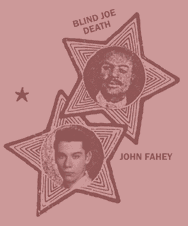Excerpts from Glenn Jones' notes for the reissue:
On Blind Joe Death 1
-Glenn Jones
Cambridge, Massachusetts, February 1996
On Blind Joe Death 1
Of the record itself, one side was credited to John Fahey, the
other to an obscure bluesman that Fahey had "discovered"
named Blind Joe Death-or at least that was the album's
intended conceit. In spite of the bluesman's rather unlikely
name, and the fact that the guitarists on both sides of the
record sounded remarkably similiar, at least one well-know
folk scholar was taken in by the hoax. This was the first of
many subterfuges perpetrated by Fahey, whose future liner
notes (and those of aide de camp, Ed Denson), would be full
of lies, in-jokes, obscure references, and absurdities, often
written in a tone that mocked the texts of prominent blues
scholars and folklorists of the day. Considering the fact that Fahey was then as wellknown as his invented blues counterpart, one wonders how
many people outside Fahey's immediate circle of friends
"got" the joke (or cared), or why he bothered to perpetrate
such a deception in the first place. Though the deeper
answers to that question must lie in the recesses of Fahey's
noggin, the fact is that John has always done exactly what he
wants and has sought to amuse himself first and foremost.
On the first reissue:
BJD II
Rather than simply repressing the original "gas station" edition of the album, Fahey felt his playing had improved enough
to warrant recording anew several tracks he was no longer
satisfied with, which he did in April of 1964. Though the cover
of the reissue would declare that Fahey had newly recorded
five songs for the second edition ("On Doing an Evil Deed Blues," "In Christ There Is No East or West," "The
Transcendental Waterfall," "Desperate Man Blues," and
"Uncloudy Day"), a comparison of the tracks made in '59 and
'64 reveals that "Uncloudy Day" is the same recording. "St.
Louis Blues" was slightly edited from the 1959 original, eliminating the song's opening verse. Dropped altogether was
Fahey's version of Blind Blake's "West Coast Blues." (John
was never pleased with his recordings of the song. He later
claimed he couldn't use the original version because the only
surviving copy of the album had a bullet hole through the
track!) To compensate for the missing song Fahey recorded
a nearly 11-minute take of "The Transcendental Waterfall,"
expanding the length of the original version by some four
minutes. This song is important as an early example of
Fahey's stretching of musical form and harmony. His experimentation with noise and meaningful dissonance was still
coming into focus. "'...Waterfall' was premature," notes
John; "only now can I play that kind of stuff."
The second pressing--a 10-song, monophonic album--was
issued late in 1964. The new edition maintained the Blind Joe
Death charade. Only slightly more elaborately packaged
than the first, the album came in a plain white cardboard
sleeve with "John Fahey" printed on one side of its cover
and "Blind Joe Death" on the other in large block type.
Included with the new edition were liner notes by Denson
and one "Chester C. Petranick." (Fahey chose as his alias the
name of his high school guidance counselor.) Spoofing the
sort of scholarly booklets that Folkways and other such
labels included with their records. Fahey and Denson's
colorfully concocted notes were a mix of manifesto and
manifest nonsense.
The second reissue:
For several years major labels had been issuing records in
both mono and stereo formats. By 1967 Takoma was doing
well enough financially to justify the recording of Fahey's
first and second albums for the burgeoning stereo market.
Thus Vol.1: Blind Joe Death, as the record would be titled
henceforth, was recorded for the third time and it is probably
this release that most people are familiar with today.
For the new version Fahey recorded all but one song on
the album. (The recording of "The Transcendental Waterfall"
used on BJDIII was the one recorded for BJDII with about
four minutes lopped off.) He recorded one new track for the
reissue: "I'm Gonna Do All I Can for My Lord." His new take
of the Episcopal hymn "In Christ There Is No East or West"
would become the most well-known and oft-played song on
the album. (I heard the song dozens of times throughout the
early '70s as background music for the scriptural musings of
the pious-voiced narrator of Thoughts for Tomorrow, metropolitan New York's nightly televised sermonette. This low
budget bromide was the last thing beamed out to bleary-eyed insomniacs before the station shut down its transmitter
in the wee hours of the morning.)
On the third reissue:
In preparing Blind Joe Death for reissue, it was decided to
include all of the material on BJDII and BJDIII, including the
long take of "The Transcendental Waterfall" (omitting the
edited version used on the stereo recording). "West Coast
Blues," the track which had only previously appeared on the
"gas station" edition, seems not to have survived its bullet
wounds, but a later take was discovered (from sessions
recorded in August 1964) which has never been issued
before. This release also contains the original liner notes
that came with BJDII. These will be new to many.
Cambridge, Massachusetts, February 1996
